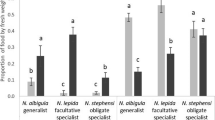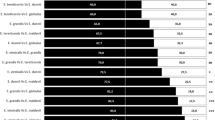Abstract
A previous study showed that Sitka black-tailed deer (Odocoileus hemionus sitkensis) consumption was negatively correlated with monoterpene content in western redcedar (Thuja plicata). To test whether these monoterpenes were deterrent to Sitka black-tailed deer, we performed feeding choice experiments with four hydrocarbon (sabinene, myrcene, α-pinene, and d + l-limonene) and one oxygenated (α,β-thujone) monoterpene solution at their highest natural concentration in western redcedar foliage. To test whether deer response was species specific, we ran similar experiments on European roe deer (Capreolus capreolus) and rusa deer (Cervus timorensis russa). In all experiments, monoterpenes were repellent. Solutions with α,β-thujone, the major monoterpene in redcedar leaves, were the most repellent of the solutions tested. We then analyzed how black-tailed and roe deer responded to (1) an increase in concentration of the monoterpenes with the weakest repellent effects (hydrocarbon monoterpenes) and (2) a decrease in concentration of the monoterpene with strongest effect (α,β-thujone). Repellency tended to increase with concentration for hydrocarbon monoterpenes, but remained strong for α,β-thujone. As wild deer regularly feed on plants containing monoterpenes, this raises the question as to how the animals deal with these molecules.
Similar content being viewed by others

REFERENCES
Banthorpe, D. and Charlwood, V. 1980. The terpenoids, pp. 185–220, in E. Bell and V. Charlwood (eds). Encyclopedia of Plant Physiology, Berlin, Germany.
Behan, B. and Welch, B. L. 1985. Black sagebrush: mule deer winter preference and monoterpenois content. J. Range Manage. 38:278–280.
Bohlmann, J. and Croteau, R. 1999. Diversity and variability of terpenoid defenses in conifers: molecular genetics, biochemistry and evolution of the terpene synthase gene family in grand fir (Abies grandis), pp. 132–146, in D. J. Chadwick and J. A. Goode (eds). Insect Plant Interactions and Induced Plant Defense. John Wiley & Sons, New York.
Carl, G. C. and Guiguet, C. J. 1972. Alien animals in British Columbia. B. C. Provincial Museum Handbook No. 14, Victoria, British Columbia.
Chardonnet, P. 1988. Etude de la faisabilité technique et économique de l' élevage de cerfs en Nouvelle- Calédonie. IEMVT/ADRAF, Nouméa.
Cluff, L., Welch, B. L., Pederson, J. C., and Brotherson, J. D. 1982. The concentration of monoterpenoids in rumen ingesta of wild mule deer browsing on a big sagebrush winter range. J. Range Manage. 35:192–194.
Coates, K. D., Pollack, J. C., and Barker, J. E. 1985. The effect of deer browsing on the early growth of three conifer species in the Queen Charlotte Islands. Research Report, No. RR85002-PR, British Columbia Ministry of Forest, Canada.
Connolly, G. E., Ellison, B. O., Fleming, J. W., Geng, S., Kepner, R. E., Longhurst, W. M., Oh, J. H., and Russel, G. F. 1980. Deer browsing of Douglas-fir trees in relation to volatile terpene composition and in vitro fermentability. For. Sci. 26:179–193.
Cowan, I. M. 1989. Birds and mammals on the Queen Charlotte Islands., pp. 175–187, in G. G. E. Scudder and N. Gessler (eds). The Outer Shores. Queen Charlotte Islands Museum Press, Skidegate, Haida, Gwaii, British Columbia, Canada.
Cronin, G. and Hay, M. E. 1996. Suceptibility to herbivores depends on recent history of both the plant and animal. Ecology 77:1531–1543.
Duncan, A. J., Hartley, S. E., and Iason, G. R. 1994. The effect of monoterpene concentrations in Sitka spruce (Picea sitchensis) on the browsing behaviour of red deer (Cervus elaphus). Can. J. Zool. 72:1715–1720.
Duncan, A. J., Hartley, S. E., and Iason, G. R. 1998. The effect of previous browsing damage on the morphology and chemical composition of Sitka spruce (Picea sitchensis) saplings and on their subsequent susceptibility to browsing by red deer (Cervus elaphus). For. Ecol. Manage. 103:57–67.
Elliott, S. and Loudon, A. 1987. Effects of monoterpene odors on food selection by Red deer calves (Cervus elaphus). J. Chem. Ecol. 13:1343–1349.
Elston, D. A., Illius, A. W., and Gordon, I. J. 1996. Assessment of preference among a range of options using log ratio analysis. Ecology 77:2538–2548.
Estell, R. E., Fredrickson, E. L., Anderson, D. M., Havstad. K. M., and Remmenga, M. D. 1998a. Relationship of tarbush leaf surface terpene profile with livestock herbivory. J. Chem. Ecol. 24:1–12.
Estell, R. E., Fredrickson, E. L., Tellez, M. R., Havstad, K. M., Shupe, W. L., Anderson, D. M., and Remmenga, M. D., 1998b. Effects of volatile compounds on consumption of alfalfa pellets by sheep. J. Anim. Sci. 76:228–233.
Estell, R. E., Fredrickson, E. L., Anderson, D. M., Havstad, K. M., and Remmenga, M. D. 2000. Effect of individual terpenes on consumption of alfalfa pellets by sheep. J. Anim. Sci. 78: 1636–1640.
Gargominy, O., Bouchet, P., Pascal, M., Jaffre, T., and Tourneur, J. C. 1996. Conséquences des introductions d'espéces animales et végétales sur la biodiversité en Nouvelle-Calédonie. Rev. Ecol. (Terre Vie) 51:375–401.
Hiroi, T., Miyazaki, Y., Kobayashi, Y., Imaoka, S., and Funae, Y. 1995. Induction of hepatic P450s in rat by essential wood and leaf oils. Xenobiotica 25:457–467.
HÖ LD, K. M., Sirisoma, N. S., Ikeda, T., Narahashi, T., and Casida, J. E. 2000. Alpha-thujone (the active component of absinthe): gamma-aminobutyric acid type A receptor modulation and metabolic detoxification. Proc. Natl. Acad. Sci. USA 97:3826–3831.
Lawler, I. R., Stapley, J., Foley, W. J., and Eschler, B.M. 1999. Ecological example of conditioned flavor aversion in plant-herbivore interactions: effect of terpenes of Eucalyptus leaves on feeding by common ringtail and brustail possums. J. Chem. Ecol. 25:401–415.
Millet, Y., Jouglard, J., Steinmetz, M. D., Tognetti, P., Joanny, P., and Arditti, J., 1981. Toxicity of some essential plant oils. Clinical and experimental study. Clin. Toxicol. 18:1485–1498.
Nagy, J. G., Steinhoff, H.W., and Ward, G. M. 1964. Effects of essential oils of Sagebrush on deer rumen microbial function. J. Wildl. Manage. 28:785–790.
Oh, H. K., Sakai, T., Jones, M. B., and Longhurst, W. M. 1967. Effect of various essential oils isolated from Douglas fir needles upon sheep and deer rumen microbial activity. Appl. Microbiol. 15:777–784.
Oh, H. K., Jones, M. B., and Longhurst, W. M., 1968. Comparison of rumen microbial inhibition resulting from various essential oils isolated from relatively unpalatable plant species. Appl. Microbiol. 16:39–44.
Personius, T. L., Wambolt, C. L., Stephens, J. R., and Kelsey, R. G. 1987. Crude terpenoid influence on mule deer preference for Sagebrush. J. Range Manage. 40:84–88.
Pojar, J., Lewis, T., Roemer, H., and Wilford, D. J. 1980. Relationships between introduced Blacktailed deer and the plant life in the Queen Charlotte Islands, British Columbia. Unpublished report. British Columbia Ministry of Forest, Smithers, British Columbia, Canada.
Provenza, F. D. 1995. Postingestive feedback as an elementary determinant of food preference and intake in ruminants. J. Range Manage. 48:2–17.
Provenza, F. D. 1996. Acquired aversions as the basis for varied diets of ruminants foraging on rangelands. J. Anim. Sci. 74:2010–2020.
Riddle, R. R., Taylor, C. A., Kothmann, M. M., and Huston, J. E. 1996. Volatile oil content of ashe are redberry juniper and its relationship to preference by Angora and Spanish goats. J. Range Manage. 49:35–41.
SAS. 1999. Release 8.00. SAS Institute Inc., Cary, North Carolina.
Schwartz, C. C., Nagy, J. G., and Regelin, W. L., 1980. Juniper oil yield, terpenoid concentration, and antimicrobial effects on deer. J. Wildl. Manage. 44:107–113.
Spalinger, D. E., Cooper, S. M., Martin, D. J., and Shipley, L. A. 1997. Is social learning an important influence on foraging behavior in white-tailed deer? J. Wildl. Manage. 61:611–621.
Tixier, H., Duncan, P., Maizeret, C., Poirel, C., and Bertrand, R. 1998. The development of feeding selection in roe deer. Behav. Proc. 43:33–42.
Trapp, S. and Croteau, R. 2001. Defensive resin biosynthesis in conifers. Annu. Rev. Plant. Physiol, Plant. Mol. Biol. 52:689–724.
Villalba, J. J. and Provenza, F. D. 2000. Roles of flavor and reward intensities in acquistion and generalization of food preferences: do strong plant signals always deter herbivory? J. Chem. Ecol. 26:1911–1922.
Vourc'h, G., Martin, J.-L., Duncan, P., EscarrÉ, J., and Clausen, T. P. 2001. Defensive adaptations of Thuja plicata to ungulate browsing: a comparative study between mainland and island populations. Oecologia 126:84–93. MONOTERPENES AND DEER FEEDING 2427
Vourc'h, G., Vila, B., Gillon, D., EscarrÉ, J., Guibal, F., Fritz, H., Clausen, T. P., and Martin, J.-L., 2002. Disentangling the causes of damage variation by deer browsing on long-lived tree saplings: A chemical and dendrochronological approach. Oikos. 98:271–283.
Welch, B. L. and Pederson, J. C. 1981. In vitro digestibility among accession of big sagebrush by wild mule deer and its relationship to monoterpenoid content. J. Range Manage. 34:497–500.
Welch, B. L., MCarthur, D. E., and Davis, J. N. 1983. Mule deer preference and monoterpenoids (essential oils). J. Range Manage. 36:485–487.
Zahorik, D. M. and Houpt, K. A. 1991. Species differences in feeding strategies, food hazards, and the ability to learn food aversions. pp. 289–310, in A. C. Kamil and T. D. Sargent (eds). Foraging Behavior. Garland, New York.
Author information
Authors and Affiliations
Rights and permissions
About this article
Cite this article
Vourc'h, G., De Garine-Wichatitsky, M., Labbé, A. et al. Monoterpene Effect on Feeding Choice by Deer. J Chem Ecol 28, 2411–2427 (2002). https://doi.org/10.1023/A:1021423816695
Published:
Issue Date:
DOI: https://doi.org/10.1023/A:1021423816695



